Themed collection Theoretical Modelling at Nano-bio Interfaces

Theoretical modeling of interactions at the bio-nano interface
Ruhong Zhou, Thomas Weikl and Yu-qiang Ma introduce the Nanoscale themed issue on Theoretical Modelling at Biointerfaces.

Nanoscale, 2020,12, 10426-10429
https://doi.org/10.1039/D0NR90092C
Computational investigation of geometrical effects in 2D boron nitride nanopores for DNA detection
Boron nitride nanopores with circular, hexagonal, quadrangular and triangular shape were studied for their potential in DNA detection.
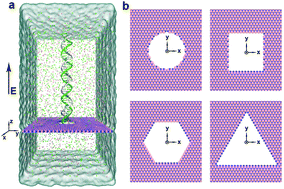
Nanoscale, 2020,12, 10026-10034
https://doi.org/10.1039/C9NR10172A
Size-dependent aggregation of hydrophobic nanoparticles in lipid membranes
Aggregation of hydrophobic spherical nanoparticles in lipid membranes depends on nanoparticle size. Nanoparticles of ∼3 nm sense and induce membrane curvature.
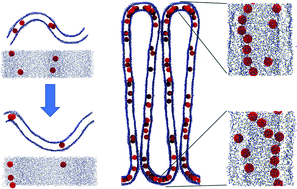
Nanoscale, 2020,12, 9452-9461
https://doi.org/10.1039/D0NR00868K
Binding patterns and dynamics of double-stranded DNA on the phosphorene surface
Molecular dynamics simulations and electrophoresis experiments show that dsDNA can form a stable binding on the phosphorene surface through the terminal base pairs and adopt an upright orientation regardless of its initial configurations.

Nanoscale, 2020,12, 9430-9439
https://doi.org/10.1039/D0NR01403F
Pore formation induced by nanoparticles binding to a lipid membrane
A nanoparticle needs to be both sharp and large enough in order to spontaneously pierce a membrane.
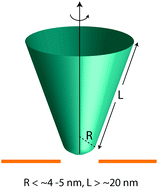
Nanoscale, 2020,12, 7902-7913
https://doi.org/10.1039/C9NR10534D
Enhancing the targeting ability of nanoparticles via protected copolymers
In this work, we reported a comprehensive study showing that protected copolymers can be harnessed to maximize the uptake difference between the cancer cells and the normal cells by using molecular simulations and in vitro experiments.
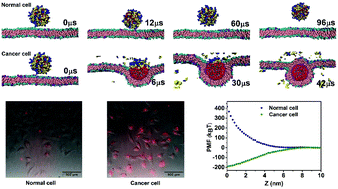
Nanoscale, 2020,12, 7804-7813
https://doi.org/10.1039/D0NR01176B
Nanoscale in silico classification of ligand functionalised surfaces for protein adsorption resistance
Non-specific protein adsorption represents a challenge for the design of efficient and safe nanoparticles for biomedical applications. An in silico method is presented to design ligands imparting protein resistance to functional surfaces.
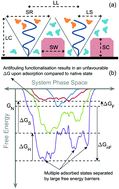
Nanoscale, 2020,12, 7240-7255
https://doi.org/10.1039/C9NR10009A
Length feature of ssDNA adsorption onto graphene oxide with both large unoxidized and oxidized regions
DNA/GO functional structures have been widely used in biosensors, biomedicine and materials science.
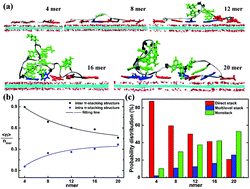
Nanoscale, 2020,12, 6699-6707
https://doi.org/10.1039/C9NR10170E
A biointerface effect on the self-assembly of ribonucleic acids: a possible mechanism of RNA polymerisation in the self-replication cycle
The self-assembly was found to be more favoured in a vesicle-cell membrane, rather than in the bulk system. The result will contribute to a better understanding of the origin of life on the primitive Earth.
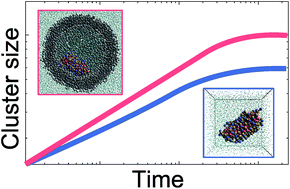
Nanoscale, 2020,12, 6691-6698
https://doi.org/10.1039/C9NR09537C
Permeation of nanoparticles across the intestinal lipid membrane: dependence on shape and surface chemistry studied through molecular simulations
In-silico design & testing of nanoparticles for oral drug delivery applications.
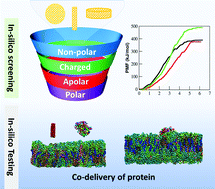
Nanoscale, 2020,12, 6318-6333
https://doi.org/10.1039/C9NR09947F
Thermo- and pH-responsive fibrillization of squid suckerin A1H1 peptide
The aggregation and disaggregation of A1H1 peptides is pH and temperature-dependent. The thermo- and pH-responsive properties of A1H1 aggregates may enable novel applications, such as drug delivery, diagnostics, tissue engineering, and biosensors.
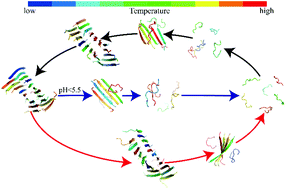
Nanoscale, 2020,12, 6307-6317
https://doi.org/10.1039/C9NR09271D
Protein unfolding by SDS: the microscopic mechanisms and the properties of the SDS-protein assembly
Molecular dynamics simulations reveal how anionic surfactant SDS and heat unfold full-length proteins.
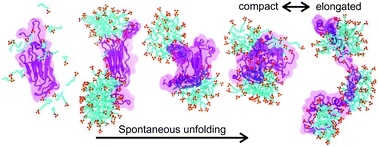
Nanoscale, 2020,12, 5422-5434
https://doi.org/10.1039/C9NR09135A
Anisotropic protein diffusion on nanosurface
The migration of protein is regulated by the puckered surface of α-PC, resulting in quick and highly directional diffusion. In combination with the bio-compatibility, α-PC is expected to be a novel functional drug delivery agent in biomedical research.
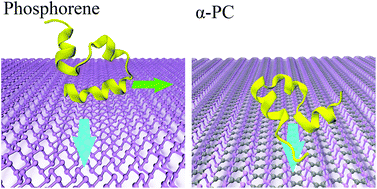
Nanoscale, 2020,12, 5209-5216
https://doi.org/10.1039/C9NR08555F
Orientational DNA binding and directed transport on nanomaterial heterojunctions
Directional DNA transporting is realized by formation of in-plane nanomaterial heterojunction where the DNA maintains a stable helix structure. This phenomenon could guide the future studies of design of functional nano-heterojunctions for biomedical applications.
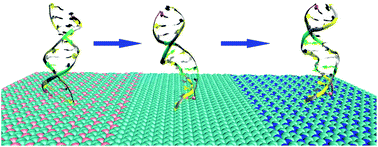
Nanoscale, 2020,12, 5217-5226
https://doi.org/10.1039/C9NR09166A
Potential interference with microtubule assembly by graphene: a tug-of-war
With the ever-increasing demand for graphene-based materials and their promising applications in numerous nanotechnologies, the biological effects of graphene on living systems have become crucial and ought to be well understood.
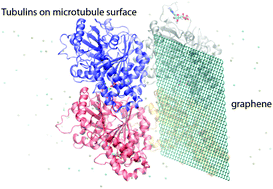
Nanoscale, 2020,12, 4968-4974
https://doi.org/10.1039/C9NR10234E
Simulated revelation of the adsorption behaviours of acetylcholinesterase on charged self-assembled monolayers
Electrostatically driven enzyme orientation leads to different enzyme activities and electron transfer rates on different charged surfaces.
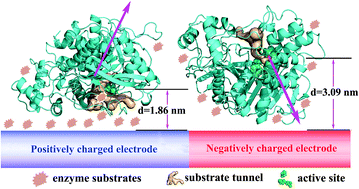
Nanoscale, 2020,12, 3701-3714
https://doi.org/10.1039/C9NR10123C
Nanoparticle translocation across the lung surfactant film regulated by grafting polymers
Conditioning of grafting polymers, including their length, terminal charge, and grafting density, can result in different translocation processes of nanoparticles across the lung surfactant film.
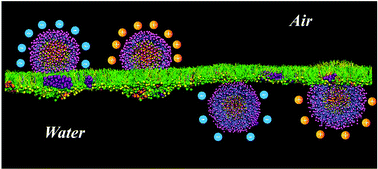
Nanoscale, 2020,12, 3931-3940
https://doi.org/10.1039/C9NR09251J
Optimization of hydrophobic nanoparticles to better target lipid rafts with molecular dynamics simulations
Due to different interactions between lipids and proteins, a plasma membrane can segregate into different membrane domains.
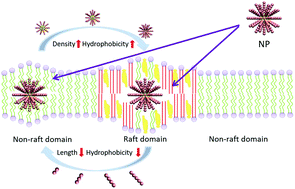
Nanoscale, 2020,12, 4101-4109
https://doi.org/10.1039/C9NR09226A
Expanding the structural diversity of peptide assemblies by coassembling dipeptides with diphenylalanine
Coassembly of dipeptides and FF leads to diverse nanostructures.
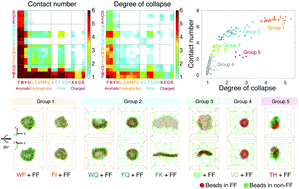
Nanoscale, 2020,12, 3038-3049
https://doi.org/10.1039/C9NR09317F
The effect of phenylalanine ligands on the chiral-selective oxidation of glucose on Au(111)
It is shown that L-Phe-capped Au(111) prefers to adsorb D-glucose and, similarly, D-Phe-capped Au(111) prefers to adsorb L-glucose.
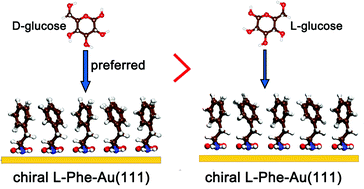
Nanoscale, 2020,12, 3050-3057
https://doi.org/10.1039/C9NR09506C
Radial aggregation of proteins prevails over axial aggregation on membrane tubes
Our simulations show that radial aggregation of proteins prevails over axial aggregation on membrane tubes.
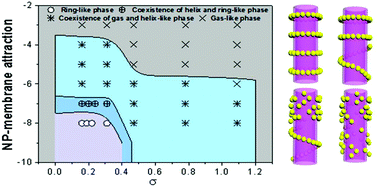
Nanoscale, 2020,12, 3029-3037
https://doi.org/10.1039/C9NR09303F
Mechanistic modeling of spontaneous penetration of carbon nanocones into membrane vesicles
Truncated carbon nanocones with a length comparable to the thickness of a vesicle membrane can self-insert into the membrane and cause cell-related toxicity.
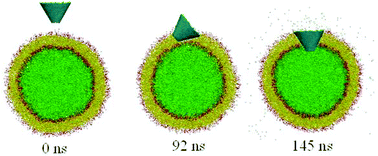
Nanoscale, 2020,12, 2686-2694
https://doi.org/10.1039/C9NR09098C
The role of electrostatic potential polarization in the translocation of graphene quantum dots across membranes
With GQDs changed from non-polarized to highly polarized, the favorable location of GQDs in the simulation system translocated from the inner membrane region to the membrane–water interface.
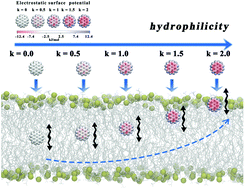
Nanoscale, 2020,12, 2732-2739
https://doi.org/10.1039/C9NR09258G
Membrane lipids destabilize short interfering ribonucleic acid (siRNA)/polyethylenimine nanoparticles
Negatively charged lipids destabilize siRNA/PEI nanoparticles, which could adversely affect their gene delivery performance.
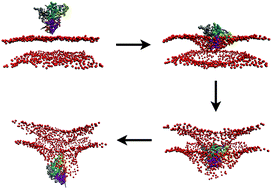
Nanoscale, 2020,12, 1032-1045
https://doi.org/10.1039/C9NR08128C
Optimal ligand–receptor binding for highly efficient capture of vesicles in nanofluidic transportation
Tailoring the intrinsic properties can be a versatile strategy in optimizing the ligand–receptor binding towards advantageous biomedical applications.
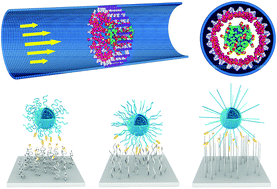
Nanoscale, 2019,11, 22305-22315
https://doi.org/10.1039/C9NR07337J
The molecular mechanism of robust macrophage immune responses induced by PEGylated molybdenum disulfide
Molecular dynamics simulation and experiments reveal that PEGylated MoS2 triggers more sustained stimulation to macrophage than pristine MoS2via slower/prolonged membrane penetration and stronger membrane adsorption.

Nanoscale, 2019,11, 22293-22304
https://doi.org/10.1039/C9NR04358F
Polymer stiffness governs template mediated self-assembly of liposome-like nanoparticles: simulation, theory and experiment
This study suggests that the self-assembly of a template-mediated liposome (TML) can be utilized as a general method to produce liposomes with controlled sizes.

Nanoscale, 2019,11, 20179-20193
https://doi.org/10.1039/C9NR07063J
Curvature-mediated cooperative wrapping of multiple nanoparticles at the same and opposite membrane sides
Combining molecular dynamics simulations and theoretical analysis, we reveal the importance of the magnitude and direction of the membrane bend in regulating curvature-mediated interactions and cooperative wrapping of multiple nanoparticles.
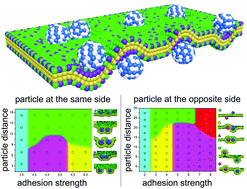
Nanoscale, 2019,11, 19751-19762
https://doi.org/10.1039/C9NR03554K
About this collection
Guest Edited by Professor Yuqiang Ma (Nanjing University, China), Professor Ruhong Zhou (Columbia University, USA) and Professor Thomas Weikl (Max Planck Institute of Colloids and Interfaces, Germany).
This collection aims to highlight the most recent and high-quality theoretical/computational works on this topic, which we believe can deepen the understanding of the interaction of nano-bio interface at the molecular level, and may also provide useful guidelines on experimental design of nanomaterials in biomedical applications.